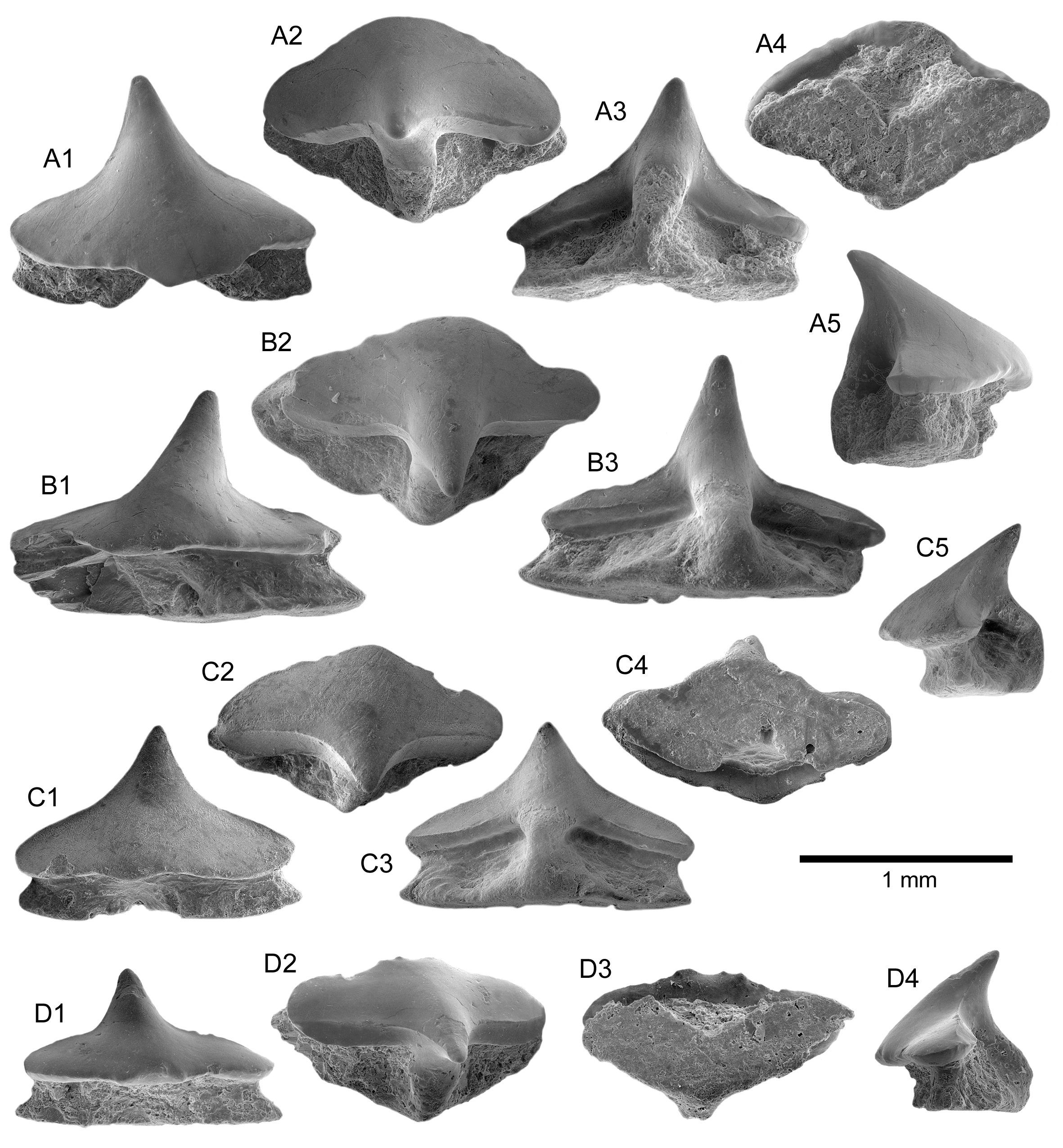
|

|
PALAEONTOS 33Price: members: 35,00 € ; non-members: 40,00 € postage is extra HÖLTKE O., UNGER E., POLLERSPÖCK J. & RASSER M.W., 2020. The elasmobranch fauna from the Upper Marine Molasse (Lower Miocene, Burdigalian) of Ursendorf (SW-Germany). 53 textpages, 7 textfigures, 2 tables, 9 plates. ISSN: 1377-465485 textpages, 8 textfigures, 61 tables Abstract:The Early Ottnangian (Early Miocene, Burdigalian) marine deposit of Ursendorf (Baden-Württemberg, South Germany) belongs to the Upper Marine Molasse (UMM) unit in the Northern Alpine Foreland Basin. The outcropping sediments mainly consist of coarse-grained, poorly sorted sands, partly showing large-scale cross-bedding. In these sediments, 24 genera of sharks and rays could be identified (Aetobatus, Araloselachus, Carcharias, Carcharhinus, Carcharodon, Carcharoides, Centrophorus, Dasyatis, Echinorhinus, Galeocerdo, Hemipristis, Isurus, Otodus (Megaselachus), Mitsukurina, Myliobatis, Notorynchus, Odontaspis, Pachyscyllium, Physogaleus, Pseudocarcharias, Raja, Rhinoptera, Squatina, Taeniurops), five of which are extinct (Araloselachus, Carcharoides, Otodus (Megaselachus), Pachyscyllium, Physogaleus). Nearly all the taxa fed on invertebrates (squid, shrimps, etc.) and/or bony fishes. One taxon (Galeocerdo) is a more ‘generalistic’ feeder on invertebrates and fishes as well as on seabirds, snakes, turtles and marine mammals. Otodus (Megaselachus) and possibly also Carcharodon mainly preyed on marine mammals as well as bony fishes. The invertebrate remnants found in the same sediments (Mollusca, Bryozoa, etc.) as well as the bony fish teeth (Sparidae) indicate a typical soft-bottom community in temperate shallow water below the storm wave base. The rich invertebrate fauna and the bony fishes were a rich food supply for the sharks and rays. In order to compare Ursendorf with 16 other UMM localities in South Germany and Switzerland, a cluster analysis was conducted. In all of the three calculated indices, the Ursendorf shark fauna is most similar to that of Ballendorf, Baltringen, Ulm-Ermingen and Walbertsweiler (all in Baden-Württemberg), Benken (Switzerland) and Neuburg am Inn-Höch (Bavaria). This similarity can be explained by palaeogeographic and palaeoenvironmental features. REINECKE T., POLLERSPÖCK J., MOTOMURA H., BRACHER H., DUFRAING L., GÜTHNER T. & VON DER HOCHT F., 2020. Sawsharks (Pristiophoriformes, Pristiophoridae) in the Oligocene and Neogene of Europe and their relationships with extant species based on teeth and rostral denticles. ISSN: 1377-4654107 textpages, 44 textfigures, 5 tables. Abstract: In the fossil record, sawsharks (family Pristiophoridae BLEEKER, 1859) include the genera Pristiophorus MÜLLER & HENLE, 1837, Pliotrema REGAN, 1906 and Ikamauius KEYES, 1979, which are mainly or exclusively represented by isolated lateral denticles of their saw-like rostra or less commonly (Pristiophorus) also by tiny oral teeth. We studied a large collection of fossil pristiophorid rostral denticles and oral teeth obtained from numerous localities exposing marine deposits of Rupelian to Tortonian age (Lower Oligocene to Upper Miocene) in the North Alpine Foreland Basin, North Sea Basin, Northeastern Atlantic and Central/northern Mediterranean Sea. In order to interprete the perceptible differences in tooth and denticle morphology of the fossil material, we conducted a parallel study on oral dentitions and rostral denticles in extant taxa of the Pristiophoridae. Representative samples of upper/lower oral teeth and of lateral/ventral rostral denticles are illustrated to document the heterodonty of teeth and characteristic features of denticles. In all species a gradient monognathic heterodonty is conspicuous. A dignathic heterodonty, typical of Pristiophorus spp., is mainly constituted by teeth in anteriormost files of the lower jaw that are larger and more strongly cambered labially than corresponding teeth in the upper dentition. Four new species are described: Pristiophorus borealis sp nov. from the Sülstorf Formation, early to middle Chattian, Mecklenburg, northeastern Germany; Pristiophorus austriacus sp nov. from the Ebelsberg Formation, Upper Egerian regional stage (Aquitanian), Upper Austria; Pristiophorus ungeri sp nov. from the Neuhofen Formation, lower Ottnangian regional stage (middle Burdigalian), Lower Bavaria, southern Germany and Pristiophorus tortonicus sp nov. from the Upper Mica Clay, early Tortonian, Schleswig-Holstein, northern Germany. For Pristiophorus suevicus JAEKEL, 1890, previously based on a lateral rostral denticle from the conglomeratic Baltringen Horizon, Baltringen Formation (middle Ottnangian, Burdigalian of southwestern Germany), we present a detailed description of oral teeth recovered from lower Ottnangian deposits of the North Alpine Foreland Basin. Palaeoenvironmental data of Paleogene and Neogene lithostratigraphic units (in a European geographical context) that commonly yield pristiophorid teeth/denticles suggest a preference of extinct sawsharks for middle to outer neritic and upper bathyal settings with soft (clayey, silty) bottoms, in agreement with the large depth range of most extant species on the middle to deep shelf and upper slope and the existence of a clear deep-water species (Pristiophorus schroederi) in the family. |
|
ORDER INFORMATION:please contact us at: palaeontos@gmail.com |
|